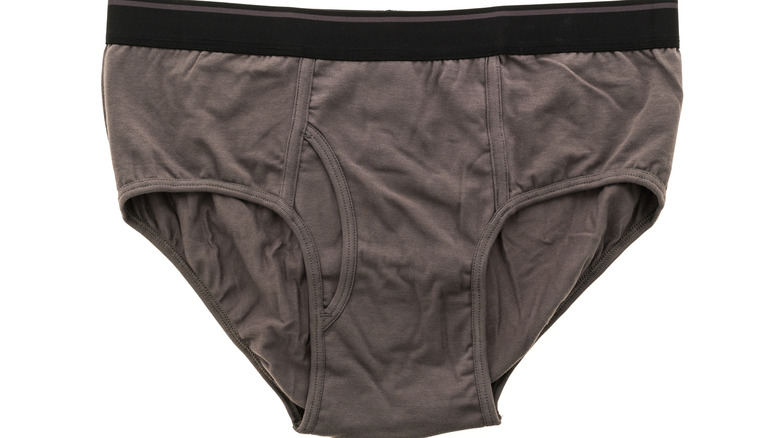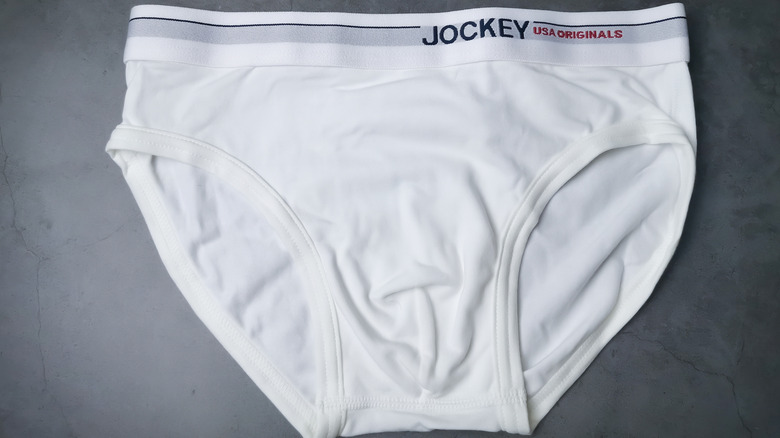A Postcard From France Led To The Invention Of The Underwear We Now Call Briefs
Although they are an integral part of getting dressed, men's underwear and its unique history are rarely discussed. According to Mental Floss, a loincloth is considered to be the first kind of men's underwear and dates back 7,000 years. In fact, Ranker reports that the oldest loincloth was discovered in 1991 with the remains of Ötzi the Iceman, a mummy from the Copper Age that is over 5,300 years old. Moreover, it's known that multiple civilizations adopted different forms of the loincloth through the years. Real Men Real Style states that this includes the ancient Egyptians, the Aztecs, and more.
However, by the 13th century, braies had become all the rage (via Ranker). Mason & Sons explains that braies are simply a pair of loose shorts. Per Mental Floss, they had to be tied firmly, which was bothersome and inconvenient, especially when one needed to use the bathroom. Eventually, a codpiece was added into the mix for practicality. This flap-like addition allowed the individual to urinate without having to take off their braies.
What followed was the invention of drawers and long johns (per The Conversation). In the 1920s, boxer shorts entered the market and in 1934, a man named Arthur Kneibler changed the underwear game forever when he designed the first pair of briefs.
Who was Arthur Kneibler?
In 1928, Arthur Kneibler was hired to work on sales and marketing at Cooper's Inc (via Jockey). The Wisconsin-based company was known for selling socks, stockings, and eventually, underwear. Founded in 1876 to manufacture socks for lumberjacks, the company shifted into selling hosiery for all ages and genders. However, in 1898, they decided to produce men's underwear. In 1912, they began selling union suits, which Real Men Real Style describes as a fitted onesie that was worn as an undergarment. Although they had been invented in the 19th century, they remained popular well into the 20th century.
Mental Floss writes that by 1934, Kneibler was working as a designer for Cooper's Inc. That same year, he received a postcard from a friend that was on vacation in the French Riviera. This friendly gesture ultimately changed Kneibler's life and history. The postcard depicted a man wearing a short and tight bathing suit bottom. A thought then came into Kneibler's mind; this style of bathing suit could undoubtedly be designed into underwear. Although boxers had been created in 1925, they had failed to become popular (per The Independent). In other words, Kneibler was taking a risk by creating this new type of men's underwear.
The tightey-whities sold out within hours
Arthur Kneibler's new underwear featured a Y-style design (which made urination more accessible) in the front and did not cover the legs or thighs. Moreover, Hunt Underwear explains that they were made with a breathable and supple fabric. In other words, they were comfortable but also incredibly stylish. Due to the amount of support they provided, the underwear were quickly named the "Jockey" short as a nod to jockstraps. However, unlike jockstraps, they covered both the genitals and the backside. Additionally, they could be worn by any man, athletic or not.
On January 19, 1935 the briefs made their debut at the Marshall Fields department store in Chicago (via Mental Floss). The weather was frigid and the design alluded to summer conditions. Yet, despite this, all 600 packages of briefs sold out by noon, as Jockey notes. In the weeks after their launch, 12,000 more packages were sold and within three months, that number had gone up to 30,000.
Needless to say, the briefs were a massive hit and were being sold in Europe, Asia, and Africa shortly after. Mental Floss writes that Cooper's Inc eventually changed their name to Jockey in 1971. According to Hunt Underwear, Jockey still exists and is still producing briefs, which are now infamously nicknamed "tighty-whities" (per Real Men Real Style).


